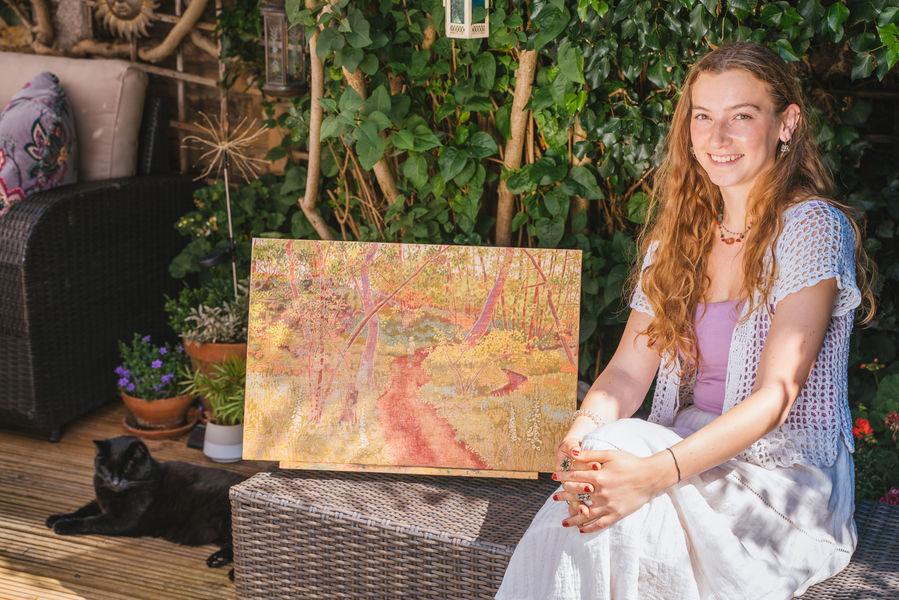NATURAL INTERMISSIONS
By Ava Haggas
13 Soho Square | Soho | London | W1D 3QF
11:00am - 7:00pm | Tue - Sun | | 06.07 – 29.07
EVENTS
Exhibition Launch | 6:00pm - 10:00pm | 06.07
Natural Intermissions, the first London solo exhibition of Ava Haggas' art, presented by BWG Gallery, is an ode to the inspiration, process, pleasure and intent found within the artist’s practice…
Haggas depicts scenes of nature in coloured pencil on wooden panels that are embellished using intricate patterns and vibrant colours which transform these scenes into Post-Impressionistic 'otherworldly landscapes'. Haggas' artworks make an 'intangible algorithm' visible as beautiful arrangements of colours and shapes which trigger a viewer's sense of calm.
The time-consuming process of Haggas' labour-intensive practice - a process in which repetitive marks and small shapes are used to create arrays of patterns which weave together like a fabric - is one that requires effort and patience to achieve a therapeutic state of inner peace. Haggas hopes a viewer sees each drawing in Natural Intermissions as a whole, whose analysis into the smaller parts and patterns triggers a hypnotic therapeutic experience. An appreciation of art forms like tapestries and Japanese wood prints is respectively evident in Haggas' weaver-like rendering of patterns with different coloured threads in broken up segments, and wood-printer-like breaking up of a landscape into simpler forms which are layered upon each other.
Presented as a large body of small to medium scale works that Haggas has developed over the past 12 months, Natural Intermissions sees transitions of time and season reflected in her flattened layering of light and colour. Dawn, daylight and dusk, Spring, Summer and Autumn are all found detailed in her sometimes subtle, sometimes intensely reimagined, combinations of form, colour and pattern. The array of artwork in this exhibition, hung to follow the rising and setting of the sun, pays homage to Haggas' stunning conservatory studio, where she witnesses this solar cycle of Nature pass over her West London garden every day. The Gallery will have a studio set up in the sun facing a bay window, allowing viewers to feel closer to Haggas' peaceful place of creation whilst experiencing her exhibition.
Haggas' unique approach to drawing Nature sees her decorative and symbolic, and in particular Post Impressionistic, Synthesist and Art Nouveau, influences manifest. Post Impressionist parallels with Haggas' art can be drawn in Bonnard's cheerful response to Japanese art and its use of bold geometric patterns, as well as his devotion to decorative art. We see likenesses in Seurat's passions for logical abstraction and mathematical precision. The development of Synthesism by Gauguin and his contemporaries is reflected in Haggas' use of two-dimensional flat patterns, working more from memory and less directly from Nature. Important parallels also exist between Haggas' work and the effective use of the flattening of perspectives and playful, sensual mixes of colours and shapes in Klimt's Attersee paintings, alongside his penchant for relaxing and losing himself in painting the natural world of plants and flowers. We find likenesses to Art Nouveau heavyweights like Alphonse Mucha's floral patterns displayed in his Documents Decoratifs and commercial art posters; and William Morris who, deeply inspired by Nature, led an arts and crafts movement of stylised decorative textile design that included leaf, vine and flower patterns that he observed during his garden and countryside walks.
Beyond her impulsion to visually imagine beauty in her art, Haggas puts faith in 'the decorative', idealising - as Gustav Klimt also fought for - the depth, meaning and almost spiritual symbolism inherent in ornate artworks. An important aspect of the ornate decoration of Haggas' drawings are their signature borders, which frame each work using a unique geometrical pattern that encapsulates and harmonises each artwork's colour palette.











